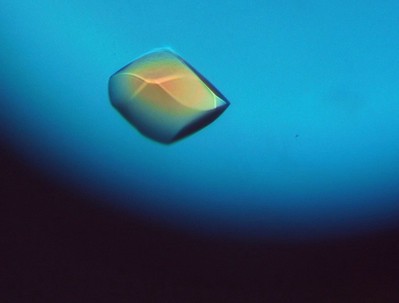Computer-Aided Protein Design for New Biomaterials
10/16/2023

A protein crystal.
[Reprinted under a Creative Commons license (CC BY-NC-SA 2.0 DEED). creativecommons.org/licenses/by-nc-sa/2.0/]
The Science
Protein crystallization plays a central role in structural biology research, yet the crystallization process remains poorly understood and highly empirical. Crystal contacts, lattice packing arrangements, and space group preferences are largely unpredictable. Programming protein crystallization through precisely engineered side-chain–side-chain interactions across protein–protein interfaces is therefore an outstanding challenge.
Efforts to understand protein structure and manipulate function typically begin with crystallization followed by X-ray diffraction to determine the molecular arrangement of atoms. Computational protein design now enables scientists to explore ways to use proteins to create completely new materials with precisely tuned characteristics such as lattice dimension and pore size.
Using a computer-based approach, researchers designed porous protein crystals that were revealed to be stable, tunable, and atomically accurate using X-ray scattering and diffraction at the Advanced Light Source (ALS).
The Impact
This study’s computational approach enables highly accurate design of protein crystals. The designed crystals, which are encoded with both structural and assembly information in their primary sequences, provide a powerful platform for biological materials engineering.
The Summary
This study developed a general computational approach for designing three-dimensional protein crystals with prespecified lattice architectures at atomic accuracy that hierarchically constrains the overall number of degrees of freedom of the system. Researchers designed three pairs of oligomers that can be individually purified and spontaneously self-assemble into >100 µm three-dimensional crystals upon mixing. The crystal structures are nearly identical to the computational design models, closely corresponding in both overall architecture and the specific protein–protein interactions. The crystal unit cell dimensions can be systematically redesigned while retaining space group symmetry and overall architecture, and the crystals are extremely porous and highly stable.
Funding
Howard Hughes Medical Institute; Amgen; Novo Nordisk; Institute for Protein Design Directors Fund; Audacious Project at the Institute for Protein Design; Open Philanthropy Project Improving Protein Design Fund; Defense Advanced Research Projects Agency; Washington Research Foundation; Nordstrom Barrier Institute for Protein Design Directors Fund; Human Frontiers Science Program; National Institutes of Health; National Science Foundation; US Department of Energy (DOE), Office of Science, Basic Energy Sciences (BES) program; DOE Office of Science, Biological and Environmental Research program, IDAT grant; and Center for the Science of Synthesis Across Scales (a DOE BES Energy Frontier Research Center). Operation of the ALS and APS is supported by DOE BES.
Related Links
- BER Resource: Structurally Integrated Biology for the Life Sciences
- ALS News: Computer-Aided Protein Design for New Biomaterials
References
Li, Z., Wang, S., Nattermann, U. et al. 2023. “Accurate computational design of three-dimensional protein crystals.” Nature Materials 22, 1556–1563. DOI:10.1038/s41563-023-01683-1
